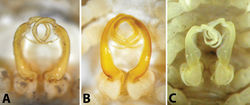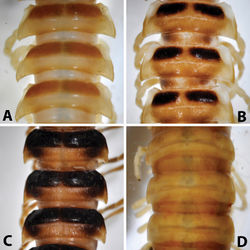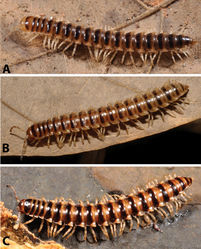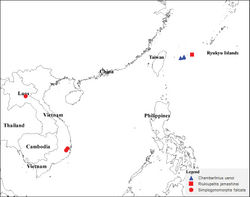Riukiupeltis jamashinai
| Notice: | This page is derived from the original publication listed below, whose author(s) should always be credited. Further contributors may edit and improve the content of this page and, consequently, need to be credited as well (see page history). Any assessment of factual correctness requires a careful review of the original article as well as of subsequent contributions.
If you are uncertain whether your planned contribution is correct or not, we suggest that you use the associated discussion page instead of editing the page directly. This page should be cited as follows (rationale):
Citation formats to copy and paste
BibTeX: @article{Nguyen2011ZooKeys156, RIS/ Endnote: TY - JOUR Wikipedia/ Citizendium: <ref name="Nguyen2011ZooKeys156">{{Citation See also the citation download page at the journal. |
Ordo: Polydesmida
Familia: Paradoxosomatidae
Genus: Riukiupeltis
Name
Riukiupeltis jamashinai Verhoeff, 1939 – Wikispecies link – Pensoft Profile
- Riukiupeltis jamashinai Verhoeff, 1939: Zoologischer Anzeiger, 127 (5/6): 125, figs 8–9.
- Riukiupeltis jamashinai:– Attems 1940[1]: Das Tierreich 70: 547, fig. 693.
- Riukiupeltis jamashinai:– Takakuwa 1954[2]: [Diplopoda of Japan], 52, figs 51–52.
- Riukiupeltis jamashinai:– Jeekel 1968[3]: On the classification and geographical distribution of the family Paradoxosomatidae (Diplopoda, Polydesmida), Nederlandse Entomologische Vereiniging: 76.
- Riukiupeltis jamashinai:– Nakamura and Korsós 2010[4]: Acta Arachnologica 59(2): 82.
Material studied
Holotype male, in fragments – only 11 segments in 5 pieces – with segments around gonopods missing, Reg.-Nr. ZSMA20052252, and two slides with gonopods, Reg.-Nr. ZSMA20035204, and legpairs 1–7, Reg.-Nr. ZSMA20035205 (all BSCZ).
New records: 2 males, 2 females, Japan, Ryukyu Archipelago, Miyako-jima Island, Rinko-abu (cave), 21 August 1979; 8 males, 2 females, Japan, Ryukyu Archipelago, Miyako-jima Island, Fukumine-no-kara (cave), 25 August 1979; 1 male, 1 female, 1 juv., 1 fragment, Japan, Ryukyu Archipelago, Miyako-jima Island, Nishibe zuzaga (cave), 26 August 1979, all leg. M. Shimojana (in the collection of M. Shimojana, Okinawa).
Distribution
Japan, Ryukyu Archipelago, Miyako-jima island.
Remarks
Although after the description of Riukiupeltis jamashinai in 1939, Jeekel (1968)[3] and Hoffman (1973)[5] commented that gonopod tibiotarsus is missing in this species, Verhoeff’s line drawing clearly shows it as depicted from the slide preparation (Fig. 1). Re-examining the type specimen and the slide of the gonopod, as well as studying newly identified specimens found in Shimojana’s collection, we are able to confirm that a gonopod tibiotarsus (=solenophore, sph in Fig. 2) is present, although it is small and closely attached to solenomere (sl in Fig. 2).
Taxon Treatment
- Nguyen, A; Korsós, Z; 2011: A revision of the millipede genus Riukiupeltis Verhoeff, 1939 (Diplopoda, Polydesmida, Paradoxosomatidae), with comments on the status of related species ZooKeys, 156: 25-40. doi
Other References
- ↑ Attems C (1953) Myriopoden von Indochina. Expedition von Dr. C. Dawydoff (1938–1939). Mémoires du Muséum National d’Histoire Naturelle, Paris {N. S., Sér. A, Zool. } 5 (3): 133-230.
- ↑ Takakuwa Y (1954) [Diplopoden aus Japan und ihn angrenzenden Gebieten]. Japan Society for the Promotion of Science, Tokyo, 241 pp.[in Japanese with German summary]
- ↑ 3.0 3.1 Jeekel C (1968) On the classification and geographical distribution of the family Paradoxosomatidae (Diplopoda, Polydesmida). Nederlandse Entomologische Vereiniging 62, 162 pp.
- ↑ Nakamura Y, Korsós Z (2010) Distribution and diversity of millipedes of the Ryukyu Archipelago, with the Senkaku and Daito Island Groups: A literature review (Arthropoda: Diplpoda). Acta Arachnologica 59 (2): 73-86. doi: 10.2476/asjaa.59.73
- ↑ Hoffman R (1973) Descriptions and allocations of new or poorly known genera and species of Paradoxosomatidae from south-eastern Asia (Diplopoda: Polydesmida). Journal of Natural History 7: 361-389. doi: 10.1080/00222937300770281
Images
|





